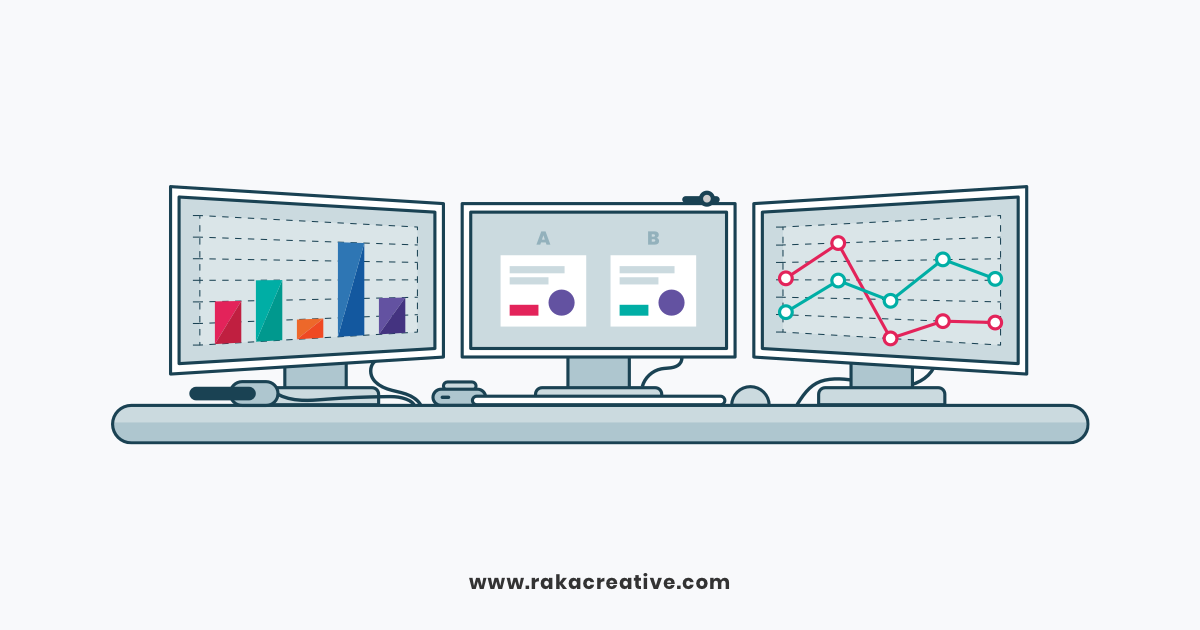We live in a world where the typical response of a business during economic uncertainty is to slash advertising spending. Despite very clear evidence of the value of advertising in uncertain times, advertising strategy is often thrown out the window as soon as there’s a hint of economic trouble.
Historically, brands that continue to maintain an advertising presence when competitors slowed or stopped spending have earned a greater share of their competitive market. In any kind of marketing landscape, it’s important to keep advertising for a few key reasons:
- Organic reach for branded content on social platforms like Facebook is dead.
- Zero-click searches–that is, searches without a click off the SERP–are on the rise.
- There’s no better time to increase market share.
It’s important not to turn your back on your advertising strategy when economic trouble hits. Let’s learn how even a small advertising budget done well can give your business an edge during this uncertain time.
Organic reach on social networks is dead
The Situation
It’s been years since Facebook showed organic branded posts in user’s feeds with any regularity. According to Facebook ads guru Neil Patel, organic reach was down to 2% in June of 2016, two years even before the announcement that it would decrease further, in 2018. Whether you prescribe to that story or the one that says organic reach on Facebook is still 6.4%, the reality is that fewer than seven out of every 100 followers of your pages will see your posts, and among those that do, the retention or recall is likely to be pretty low.
LinkedIn is no different: there’s an ongoing debate about whether we’re currently still in the golden age of LinkedIn organic reach, but what we know is that organic reach is declining on the platform. Ditto Instagram. Organic reach may or may not still be okay on Twitter, but the platform is a firehose, so unless you’re committing hours each day to creating content, curating conversations, and managing communities, you’re not likely to see a lot of return there either (frankly, this is why we discourage a lot of clients from using Twitter Ads as well—they’re great for media, but spotty for much else).
Why are social ads beneficial in a time of crisis?
- Crises usually bring out the empathy in people, and there’s no better place to be empathetic (i.e., tell a compassionate brand story) than Facebook or Instagram.
- In times of crisis, mission-based marketing tends to take priority over performance marketing. 2020 is no exception: according to the IAB, following the onset of the coronavirus pandemic, mission-based marketing increased 42%, and cause-related marketing has increased 41%. Because of the nature of social platforms and content, users will typically respond much more strongly to these types of marketing than in standard display or search channels.
- If you are going in on mission-based marketing, you may see an increase in interest from LinkedIn users, while cause-based marketing may resonate more strongly with users on Facebook and Instagram.
Your social advertising strategy is probably already taking advantage of some of these truths, but at a time of crisis, it can be even more important to lean into your brand story and show compassion for your audience. Social ads are an important part of your crisis advertising strategy because they ensure visibility with the right audiences, and they represent opportunities for your brand to develop its human side, something that most of your audience will be very interested in during and coming out of a crisis.
How organic reach on social should influence your advertising strategy
By committing even a small spend to promoting content or running social ads, your brand’s reach can skyrocket. And odds are you won’t need to change your social ad strategy or targeting to accommodate a shift in focus. With the audience targeting available in Facebook and Instagram (for retailers and B2C brands), and LinkedIn (for businesses), social ads are an easy way to grow your following while building affinity for your brand and demand for your service among those users whom you’ve already established relationships with. If you’re really smart about it, your B2C brand can cross over to LinkedIn, or your B2B company can grow its reach on Facebook, as well.
Zero-click searches are on the rise
The Situation
For the first time ever, in June of 2019, more than half of searches in Google didn’t result in a single click. This is indicative of a few things:
- The rise of informational searches – Users are more and more likely to conduct informational searches that require either a very particular or very comprehensive answer.
- The evolution of Google’s products:
- Navigational searches – It used to be that any navigational search would require a click to MapQuest or Google Maps to get the answer needed, but thanks to how well Google has integrated Maps into searches, this is no longer necessary.
- Transactional searches – Users also used to have to click to retailers’ sites if they wanted to purchase a product, but so many of those transactions can now be completed on Google.
Of course, the other part of the transactional search equation is Amazon, but that’s another topic for another day.
Of the searches that did wind up clicking away from Google, about 10% were clicks on ads. That means 90% of your search traffic should be organic and 10% should be paid, which may not the case for your brand. Well-optimized SEM campaigns can deliver huge volumes of traffic, and for businesses that are strapped for resources. It’s often easier to spend money in paid search than it is to commit the hours needed to be successful with content creation, rich content, SEO, and user experience. To be clear, we’re not recommending this approach: the foundation of any good SEM effort is a clear, concise message supported by strong content, smart promotion and easy-to-follow user paths.
How the rise of zero-click searches should impact your advertising strategy
It’s more important than ever to focus your advertising strategy on making sure that your very clear message is seen in SERPs. Even if you rank in the top two or three organic spots for all of your core keywords (which is highly unlikely), many users won’t even get to your organic listing because the combination of search ads, product ads, knowledge graphs and images will push that organic result to a page depth where your audience won’t scroll.
Suppose your brand is planning a new product or service line launch. You created landing pages or other website content promoting these new efforts and optimized your metadata the terms that your audience might search for over time. This probably means that your title tag isn’t something like “New Productivity Suite Launches 6/1”, but rather “Productivity Tools for Enterprise Resource Planning (ERP) Professionals”, right? But wouldn’t the former be a stronger call-to-action for transaction-minded searchers looking for productivity support in April or May?
Alternately, what if the crisis isn’t a global pandemic, but rather some bad news centered around your organization itself? If the media is writing lots of negative content about your brand, services, employees, or products, search advertising is one way to bump some of those negative results further down the page. If you’re not dealing with a crisis but a long-simmering reputation issue, the same can be true.
Just like you don’t want to be updating your advertising strategy all the time, you don’t want to be updating your title tags or metadata every couple of days or weeks, either. But ad copy is different: you can update it as frequently as you’d like without issue (and we recommend doing so regularly in any situation). In a world where over half of users expect to get what they need from a search page itself, using ad copy as a form of micro-public relations can go a long way.
There’s no better time to increase market share
The Situation
There are several reasons to advertise during a slowdown:
- Brands can project to consumers the image of corporate stability during challenging times.
- The cost of advertising drops during recessions. The lower rates create a “buyer’s market” for brands. Studies have shown that direct mail advertising, which can provide greater short-term sales growth, increases during a recession.
- When marketers cut back on their ad spending, the brand loses its “share of mind” with consumers, with the potential of losing current—and possibly future—sales. An increase in “share of voice” typically leads to an increase in “share of market.” An increase in market share results, with an increase in profits.
In 2008, during the last economic recession, a forecast by eMarketer notes that digital advertising spending only decreased by 2%, but states that newspaper ad spending dropped by 27% and radio by 22%. When brands began to spend advertising dollars again, they didn’t flock to traditional media, with the result that in 2019, digital media finally eclipsed traditional media buys as the place where the bulk of ad dollars were spent, according to eMarketer. Skepticism towards traditional media remains high, as even in 2020 already, traditional advertising channels such as print and TV have seen more significant declines in spend than digital channels (IAB)
In 2008, advertising spend decreased by 13%, and according to the IAB, digital spend is already down between 19-25% in 2020. The math is simple: when spend goes down, demand decreases. When demand decreases, more ad inventory becomes available and that inventory costs less, making it cheaper to get your ads out there and increase your market share.
How should the opportunity created by economic trouble impact your advertising strategy?
Remember: advertising strategies are dynamic. Times when marketing budgets are lower and customer interest is more sporadic are great times to re-evaluate your audience, message, tone and approach to marketing as a whole, not just advertising. Don’t be afraid to have the hard conversations about who you’re targeting, how you’re targeting them, what is and isn’t working, and what all that means for your marketing strategy moving forward.
Once you’re sure that you’re targeting the right people, don’t be afraid to mix up your creative or your message to test what works and what doesn’t. You’ll probably still target a lot of the same audience, bid on most of the same keywords (though you may want to revisit your bidding strategies in the short term), and spend in the same channels, so this is a good time to figure out how to do best capture their interest.
Don’t be afraid to spend in areas where you feel you have a strong message, good creative, and captive audience, even if the results aren’t as strong as you’re used to. Try to save some budget for testing so you can determine quickly what resonates with your audience and to expand upon those offerings.
To conclude, marketing and advertising shouldn’t be frowned upon just because the economy isn’t as strong as it once was. We encourage brands to explore new opportunities to engage in digital advertising, both because the competition (i.e., costs) isn’t as high and also because of the opportunity to tell a brand story that will keep users coming back to you.






